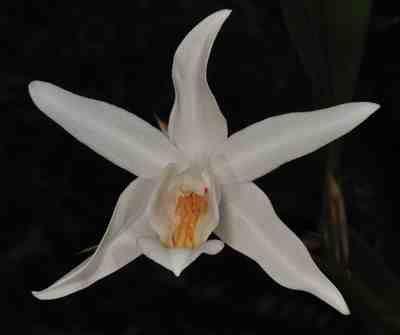Epiphyte as well as lithophyte. Pseudo-bulbs 3 to 5 cm long, cylindric, very smooth, sheathed at the base, attached rather 3 to 5 cm distant on stout rhizome. Entire plant is pendulous. Leaves in pairs, narrowed to the sessile base, linear-oblong, acute, 7 to 12 cm long and around 2 cm in width. Racemes from the base of the pseudobulbs, pendulous, about as long as the leaves. Flowers large 4 to 6 c across, white except the disc of the lip, which is yellowish orange. Sepals and petals sub-equal, oblong, with entire undulate edges. Lip oblong, with rounded lateral lobes, disc between the side lobes with four fimbriate lamellae.

The Pursuit
A plant often found in huge pendulous clusters growing on trees and rocks of the region above 7000 ft. Found this in flower on a holiday trip to a near by waterfall. However, my favourite shooting gear, 105mm/2.8 micro lens and flashes were not with me. Cutting short my trip ahead and with a promise of joining the party next day, I returned to my place to get all the flower shooting accessories. Some minor trouble with the vehicle delayed my return to the location. I reached there by evening only, by then the freshness of those flowers found in the morning was not there, and decided to find a few new ones the next day. Went ahead to the water falls to be with my friends for the evening. Started the journey before sunrise the next day so as to be at the spot to shoot the flower in full bloom. I found 28 of them in flower, it was such a wonderful sight and will remain in my mind when ever I talk about this particular species. As usual photographing a pure white flower is a very tricky affair. The latest lighting techniques I use will even make microscopic dusts visible. However, with God’s grace the one I selected to photograph was a perfect one and I had this wonderful photograph without much trouble.








